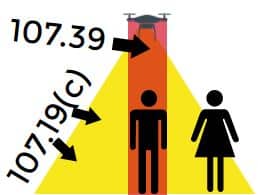A little further guidance from a Drone Law Attorney.
Part 107.19(c) (The Rarely Understood Regulation & Brother of 107.39)
So if I don’t fly over people and moving vehicles, I’m good right?
It’s not as simple as that.
Section 107.19 applies which says:
(c) The remote pilot in command must ensure that the small unmanned aircraft will pose no undue hazard to other people, other aircraft, or other property in the event of a loss of control of the small unmanned aircraft for any reason. (Emphasis mine)
Here is what this graphically looks like.
107.39 prevents you from flying directly over (red) non-participating people while 107.19(c) (yellow) requires you to “pose no undue hazard . . . in the event of a loss of control of the small unmanned aircraft for any reason.” Any reason like a propeller breaking (you are logging the time on those right to switch them out regularly?) an autopilot going nuts, GPS interference testing happening or GPS multipathing in an urban environment, etc. The
FAA did charge a guy recently with this regulation for flying over downtown Philadelphia.
Notice 107.19(c) requires you to pose no undue hazard. It’s exposure, not being over. Keep this in mind when doing your operations near people. See my
section 107.19 article for a more in-depth discussion. Or maybe take my Part 107 regulations course over at
www.rupprechtdrones.com? 
Issues Surrounding Over People Operations
The two big issues are transferring kinetic energy and lacerations.
1. Transferring Kinetic Energy
This is an area that is currently being researched to understand how unmanned aircraft transfer energy. All sorts of things go into decreasing the energy transfer such as shape of the aircraft, the material it is made of, the positioning of certain parts, the size to create a greater distance between the aircraft’s center of gravity and the most outer edge of the aircraft, etc.
Basically, an aircraft has an overall amount of energy while in flight and you have to figure out how to manage the kinetic energy levels and/or decrease the amount of transfer upon impact.
To keep energy levels low, you could fly slowly, low in altitude, into the wind, or decrease the mass of the aircraft. You could also install some type of flight termination system (parachute) which slows the aircraft down to a low kinetic energy level. Here is an impact calculator I built. Just plug in your drone and altitude to see what is your kinetic energy.
Drone Kinetic Energy Calculator
Unless you have a solid steel rod, you are NOT going to transfer all the energy into the object. All sorts of energy is dissipated by the aircraft moving, warping, rotating, compressing, etc. This is where it gets tricky in calculating things because you basically have to launch the drone into some crash test dummies (in different realistic configuration) to see what happens.
This is why in the
FAA’s over people proposed regulations, they came up with a simplified method. It’s basically assuming all the energy is being transferred and you are just doing energy management with speed, altitude, wind, mass, etc.
And here is another wrinkle in calculating things, when you distance the center of gravity of the aircraft from the center of gravity of the object being impacted, there is decrease in energy transfer because the CG of the aircraft tends to glance off and not transfer all the energy through. Imagine this. Which will transfer more energy into the object? (1) an arrow with the CG close to the back of the arrow near the feathers or (2) near the tip. (1) would result in glancing and rotating around which means it’s even less probable of nailing the target dead on where the energy would go down through the arrow shaft into the target.
Even when you have figured out calculating things (typically things are static like the aircraft’s energy transferring properties., CG, and mass) the other big hurdle is proving that the energy levels you are at are indeed safe. Is 50 foot-pounds ok? What about 100 foot-pounds? What does that do to the neck or the skull?
There has literally been hundreds and hundreds of pages published on this one point. How much energy can a person really receive and what energy levels will result in what levels of injury where?
Basically, prove a “safe” level of energy and prove your aircraft will be at the safe energy level or lower during impact.
2. Lacerations
The other concern is that these flying lawnmowers might come into contact with people and cause further injuries on top of the blunt injury. The propellers could also break and stab the person.
There needs to be a mitigation for this hazard. One is to stop the propellers if there is an emergency and another is to install prop guards/bumpers.
What Aircraft Have Been Approved to Fly Over People?
It’s really important you understand this. There are two sections here: (1) what was approved from (2016-2020) and then (2) what has been approved under the new regulations.
Some aircraft are approved by their design. Some are approved because they have a parachute system.
(2016-2020 )Aircraft & Parachute Systems
Here are some of the ones that have been approved that you can purchase today:
Here’s a list of ASTM compliant parachute systems you can purchase today that were used to obtain waivers from 2016-2020:
Coupon Codes for Parachute Systems:
- AVSS for $50 off. “AVSSRUPPRECHT50”
- Parazero for $50 off. “RUPPRECHT50”
(2021 and Onwards)Aircraft & Parachute Systems
As of the time of this writing, there have been none approved under the new regulations.





